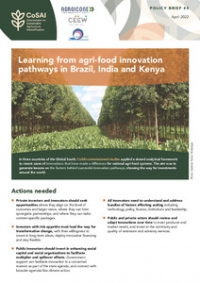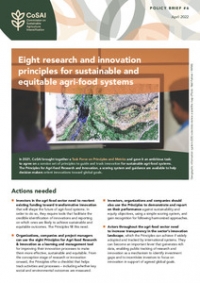Colombo, August 20, 2021
Agriculture is often blamed for the degradation of our natural environment. But if more biodiversity is integrated into agricultural land we can supply the world's growing population with a healthy diet while sequestering up to 30% of the total CO2 released into the atmosphere since the Industrial Revolution, according to a new evidence review from the CGIAR Research Program on Water, Land and Ecosystems.
Agricultural activity takes up about 40% of the global land surface and is responsible for 80% of land conversion. The obliteration of biodiversity within and outside of agricultural systems not only deprives farmers and the wider environment of the ecosystem services we all rely on, it drives the food system towards the production and consumption of unhealthy, insufficiently diverse diets – contributing to an estimated 11 million premature deaths annually.
The usual solution proposed has been to spare land from agriculture by designating protected areas. The WLE review calls for a complementary approach by sharing agricultural land with biodiversity through regenerative practices. Key findings include:
- At least 10–20% of semi-natural habitat per km3 is needed to ensure ecosystem functions such as pollination, biological control and climate regulation, but today 20% of agricultural lands have less than 10% of such natural capital
- Shifting to healthy, plant-rich diets could lead to a 20% decrease in the land needed to meet consumption demand, in line with the global goal of no net loss of nature by 2050
- Restoring 15% of converted lands in priority areas could avoid 60% of expected extinctions
- Regenerative agricultural practices have the potential to reduce CO2 emissions by 4.3–6.9 gigatonnes a year.
Sharing space with biodiversity is nothing new – it's been practiced traditionally by smallholder farmers for millennia through intercropping or other forms of regenerative agriculture. These include the maintenance of semi-natural/natural ecosystems within agricultural landscapes such as wetlands, hedgerows or perennial grass strips. But these diversified agroecological systems have become overwhelmed in recent decades by agro-industrial monocultures that deploy an excess of chemical inputs to maximize yield of a limited number of crops.
This evidence review, carried out by an international team of scientists, calls for nature-positive agriculture. Team leader Dr Fabrice DeClerck of WLE and the EAT Foundation sums up how this can be achieved:
"We need a real transformation of how agriculture is perceived and managed, and a reorientation towards regenerative and carbon-sequestering practices on a global scale. Research is needed to fill knowledge gaps, particularly on agricultural systems in low- and middle-income countries. Financial markets should redirect investments from unsustainable, unhealthy and socially unjust practices to innovations and enabling environments that drive this transformative change. Farmers large and small need to be supported to produce ecosystem services and increase production of crops that contribute to healthy diets in line with Sustainable Development Goals 2 and 3. International trade will have to be reimagined and realigned with global health, climate and environmental objectives."
Crucially, the review emphasizes access for people everywhere to the tools required to demand change from policy makers and businesses, who need to make the policy shifts needed to satisfy everyday food choices that do not cost the earth.
The review, commissioned by the UK Foreign, Commonwealth & Development Office, is part of a series of publications covering agroecology, finance and innovations to unlock solutions that support biodiversity-based approaches to agriculture, bringing us closer to planetary health goals. The findings were recently presented as part of a webinar series run by the CGIAR Research Program on Climate Change, Agriculture and Food Security in the lead-up to COP26.












